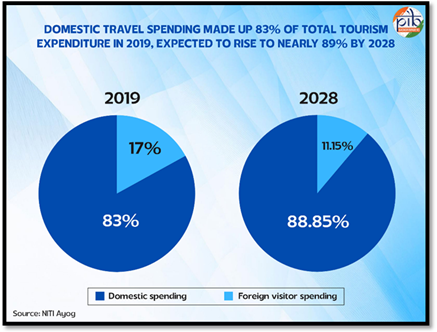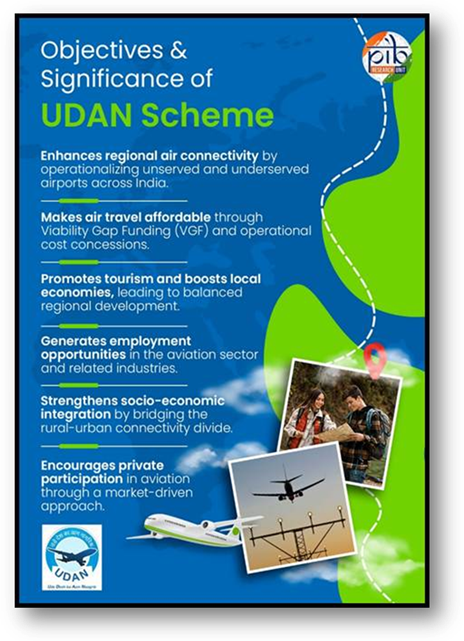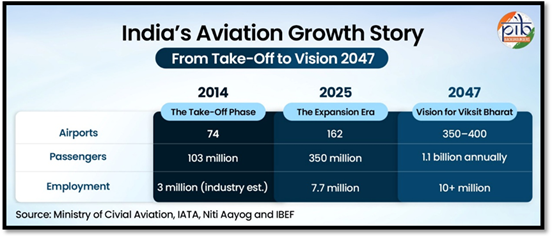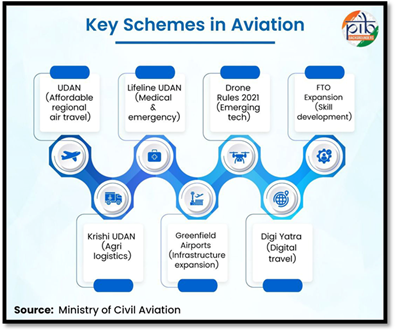PIB Headquarters
Soaring Skies, Thriving Economy: India’s Aviation Vision 2047
प्रविष्टि तिथि:
23 OCT 2025 5:07PM by PIB Delhi
Key Takeaways
- UDAN revolutionised regional connectivity — 1.56 crore passengers, 3.23 lakh flights.
- The government's vision is to increase airports to 350-400 by 2047.
- Overall, India’s aviation sector supports over 7.7 million jobs.
- Initiatives like Digi Yatra, Greenfield Airports Policy, and Drone PLI Scheme are driving innovation and ease of travel.
Introduction
Connectivity is a bridge that transforms geography into opportunity. This is not just about the current time, but history tells how regional connectivity led to the growth of regions, trade and economic exchange, making growth inclusive and balanced. Even in the current time, connectivity plays an important role not just for the tourism and trade sectors but also for emergencies and reducing dependence on external markets. Among the many factors contributing to the growth of the domestic market, UDAN (Ude Desh ka Aam Nagrik) — a regional connectivity scheme launched on 21 October 2016 — has played a pivotal role in strengthening regional air connectivity. As UDAN completes nine years today, the scheme has evolved from a pilot initiative into a national success story, bridging distances and making air travel accessible to citizens across the country.
India’s Aviation: Soaring Towards Inclusive Growth
In the last decade, India’s skies have grown busier than ever. India has emerged as the world’s third-largest domestic aviation market. The number of airports increased from 74 in 2014 to 163 in 2025. Meanwhile, as India celebrates hundred years of independence in 2047, the government's vision is to increase airports to 350-400 by then.
The aviation sector is also one of the fastest-growing sectors in India’s economy, contributing through air transport services and indirectly through tourism, trade, logistics, and manufacturing.
According to the International Civil Aviation Organization (ICAO), investments in aviation have a strong ripple effect on the economy. For every rupee spent, the sector generates more than three times that value in economic activity and supports over six times as many jobs in connected industries.
Today, the sector supports over 7.7 million jobs indirectly, including 369,000 jobs directly, the demand for skilled personnel—pilots, engineers, ground staff, and logistics professionals—is expected to rise sharply. With over 116 bilateral Air Service Agreements, India is deepening global connectivity as Indian carriers expand internationally, reinforcing the country’s position as an aviation hub in Asia. Civil aviation is also driving FDI inflows, technology transfer, and Make in India initiatives in aircraft manufacturing, ground handling, and Maintenance, Repair, and Operations (MRO) services. Over the past decade, domestic air passenger traffic has grown 10-12% annually.
By 2040, the passenger traffic is expected to grow six-fold to around 1.1 billion. India’s commercial airline fleet is predicted to grow from 400 in 2014 to around 2359 in March 2040. The total employment due to aviation sector in 2040 is expected to be around 25 million - emerging as a core engine of India’s journey towards becoming a developed economy.
UDAN: Democratizing Air Travel for Every Citizen
From metro cities to mountain valleys, the Indian sky has become a map of new possibilities — connecting small towns, enabling tourism, and driving local economies. At the heart of this transformation lies the UDAN (Ude Desh ka Aam Nagrik) scheme under Ministry of Civil Aviation (MoCA), which has democratised air travel and reshaped India’s regional connectivity landscape.
According to NITI Aayog, domestic travellers accounted for over 83% of total tourism spending in 2019, a figure expected to rise to nearly 89% by 2028. This shift shows how government initiatives like UDAN have bridged the infrastructure gap and made air travel accessible for millions, connecting remote regions and making air travel affordable and accessible.

This reflects the government’s efforts to make air travel affordable and inclusive, supported by initiatives like UDAN. This transformation has also reshaped India’s travel map. Once remote destinations— Kullu, Darbhanga, Hubballi and Shillong—are now directly connected by air, boosting local economies and regional tourism.

The vision of UDAN emphasised the need to democratize air travel, a sentiment that ignited the vision for a more inclusive aviation sector. This commitment to the common man’s dreams led to the birth of UDAN.
UDAN Achievement:
- RCS-UDAN Connecting India: The Regional Connectivity Scheme (RCS) – UDAN has operationalised 649 routes and connected 93 aerodromes (including 2 water aerodromes and 15 heliports) across the country, among which 12 airports/heliports in the North-East region. It has also integrated the Andaman, Nicobar, and Lakshadweep Islands into the national aviation network.
- Milestone Achieved: Over 1.56+ crore passengers have travelled on RCS–UDAN flights, and a total of 3.23 lakh RCS flights have been operated across regional routes nationwide. Around ₹4,300 crore in Viability Gap Funding (VGF) has been disbursed to make regional routes commercially sustainable for airlines.
- Expanded UDAN: The scheme aims to increase regional connectivity to 120 new destinations across the country, catering to 4 crore passengers in the next 10 years. The scheme will also support helipads and smaller airports in hilly, aspirational and North East region districts.
- Affordable Food at Airports with UDAN Yatri Café: The UDAN Yatri Café initiative, launched at Kolkata and Chennai airports, provides affordable, quality meals (tea at ₹10, samosa at ₹20) — making air travel more inclusive and accessible to all.
Looking Ahead: Vision For 2047
As India moves toward its centenary of independence, the aviation sector is charting an ambitious growth path — from 163 airports in 2025 to over 350 by 2047, and passenger traffic expected to cross one billion. These numbers represents a shift toward cleaner fuels, digital airways, and inclusive mobility.
With 25 million jobs projected by 2047 and expanding opportunities in MRO, drone manufacturing, and pilot training, aviation will become a vital pillar of India’s $10 trillion economy.

Meanwhile, following initiatives in aviation sector are pivotal in achieving India’s 2047 vision -- connecting remote regions, supporting livelihoods, and advancing sustainable growth.

Krishi UDAN: Launched in September 2020, Krishi UDAN enables faster transport of agricultural produce and perishables, especially to benefit the tribal and northeastern states. In convergence with the Operation Greens Scheme, it offers 50% freight subsidy, multimodal transport options, and coverage of horticulture and allied produce.
Lifeline UDAN: This special initiative was launched in March 2020, during the COVID-19 lockdown, to ensure uninterrupted medical and essential supply deliveries. Over 588 flights carried 1,000 tons of cargo across 5.45 lakh km, focusing particularly on the North Eastern region, the Islands, and hilly terrains. Lifeline UDAN also supported setting up COVID labs, transporting medical teams, and responding to emergencies like the Vishakhapatnam gas leak.
Greenfield Airports Policy: The Greenfield Airports Policy provides a framework for building new airports on unused land through public–private partnerships to expand India’s aviation infrastructure and decongest metro hubs.
Enhancing Travel Experience: To enhance the travel experience, reduce redundancy, and save time, the government has launched various initiative including Digi Yatra.Implemented from 2022 onwards, Digi Yatra enabled paperless, contactless processing of passengers using facial recognition technology. By March 2025, more than 52.2 million passengers had used this facility. Digi Yatra App is available on Android as well as iOS platforms and has been downloaded by over 12.1 million users so far.
Flight Training and Pilot Development: To meet the projected demand of 30,000–34,000 pilots in the next 10–15 years, government is expanding Flight Training Organizations (FTOs) and commercial pilot licensing. Promoting gender inclusion, with 13–18% women pilots, DGCA targets 25% female representation in all aviation roles by 2025.
Drone Rules 2021, Production-Linked Incentive (PLI): The Drone Rules, 2021, liberalized India’s drone sector by simplifying regulations and enabling wider commercial use. Complementing this, the Production-Linked Incentive (PLI) scheme, with Rs 34.79 crore disbursed in FY 24–25, has encouraged domestic manufacturing and reduced reliance on imports, boosting India’s self-reliant drone ecosystem.
Bharatiya Vayuyan Adhiniyam, 2024: Legislative reform aimed at modernizing India’s aviation sector by re-enacting the Aircraft Act, 1934, in alignment with contemporary needs and global standards. The new legislation fosters indigenous manufacturing under Make in India and Atmanirbhar Bharat initiatives, aligning with international conventions like the Chicago Convention and ICAO, and streamlining regulatory processes, such as simplification of the issuance of licenses. The Act removes redundancies and provides provisions for appeals.
Conclusion:
India’s civil aviation sector has emerged as one of the fastest-growing sectors, making the country the third-largest domestic aviation market in the world. As country continues to record unprecedented rise in passenger traffic, expand regional connectivity, and modernise aviation frameworks, the efforts by the ministry enhance travel experiences for millions and bolster economic prosperity, strengthen national integration, and empower India to confidently soar towards its vision of becoming a developed nation—Viksit Bharat @2047.
References:
https://www.iata.org/en/iata-repository/publications/economic-reports/the-value-of-air-transport-to-india
https://www.pib.gov.in/PressReleasePage.aspx?PRID=2098780
https://www.pib.gov.in/PressNoteDetails.aspx?NoteId=152143&ModuleId=3
https://www.pib.gov.in/PressReleasePage.aspx?PRID=2123537
https://www.pib.gov.in/PressReleaseIframePage.aspx?PRID=2066445
https://sansad.in/getFile/annex/266/AU669_kOqHSU.pdf?source=pqars#:~:text=Out%20of%20which%2C%20RCS%20flights,economic%20growth%2C%20and%20enhance%20tourism
https://www.iata.org/en/iata-repository/publications/economic-reports/the-value-of-air-transport-to-india
https://www.pib.gov.in/PressNoteDetails.aspx?NoteId=154624&ModuleId=3
https://www.pib.gov.in/PressNoteDetails.aspx?ModuleId=3&NoteId=153352
https://www.pib.gov.in/PressReleaseIframePage.aspx?PRID=1943211#:~:text=Government%20of%20India%20has%20formulated,these%2C%2011%20Greenfield%20airports%20viz
https://sansad.in/getFile/annex/268/AU5_1mFQzx.pdf?source=pqars#:~:text(a)%20&%20(b):,Nadu%20under%20the%20UDAN%20Scheme
https://www.pib.gov.in/PressReleasePage.aspx?PRID=2124459
https://www.pib.gov.in/Pressreleaseshare.aspx?PRID=1847005
https://www.pib.gov.in/PressReleasePage.aspx?PRID=1989139
https://www.pib.gov.in/PressReleasePage.aspx?PRID=1908939
Click here to see PDF
******
SK/M
(रिलीज़ आईडी: 2181865)
आगंतुक पटल : 3199